McAlpine Contracting celebrates grand opening of 12,900 s/f Harmony Early Learning Center in Wantagh
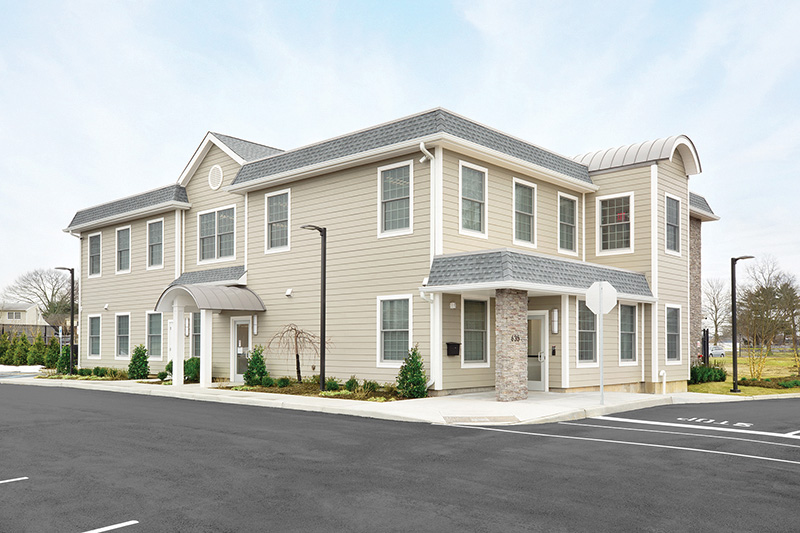
Wantagh, NY Harmony Early Learning Center, a school serving children aged six-weeks through Pre-Kindergarten, has opened its second location at 635 Wantagh Ave. The school’s opening coincides with an increased demand for childcare at the time when many parents work remotely from home and require uninterrupted work hours.
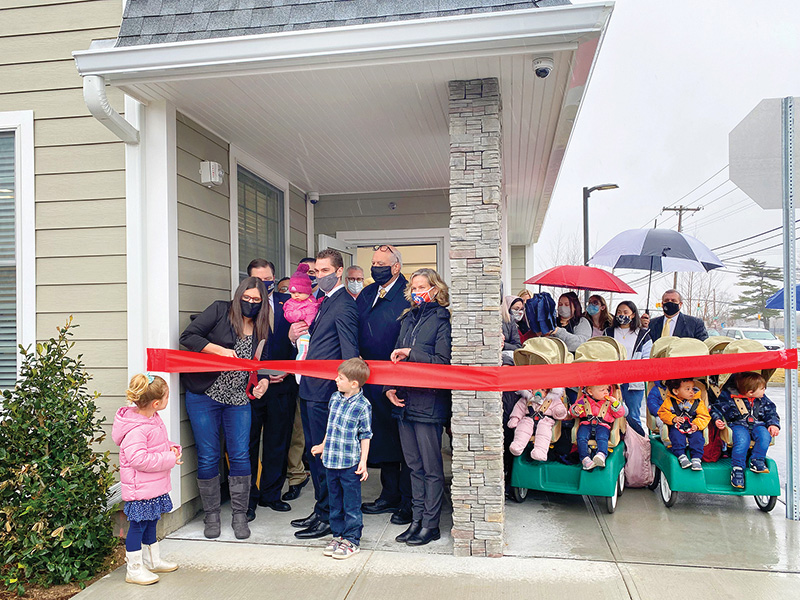
Constructed by McAlpine Contracting, the new 12,900 s/f building was designed by Michael F. McNerney Architect PLLC (MFMA) and interior designer Rachel Florez, principal of Vintage Interior Design. KOW Building Consultants served as owner’s representative for the design and construction process.
“I am thrilled to open this new location in Wantagh, so that we can expand our quality childcare services to more families in Nassau County, including many children who have been on the waiting list for our Levittown location” said Allison Ulin, Harmony’s owner and director. The Levittown center, founded in 2013, currently enrolls 47 children. “The new Wantagh school accommodates 115 children. The main objective at Harmony is to provide a safe and fun environment where children can learn, create, and explore the world around them. This new building, beautifully designed by Michael McNerney and Vintage Interior Design and built by McAlpine, KOW, and five months ahead of schedule, will become that special place.”
Harmony’s educational program uses the nationally recognized, research-based Creative Curriculum. The school’s staff follows a “whole child approach” educational philosophy, which supports and nurtures all areas of a child’s development. Along with the full-year daycare and preschool, Harmony also operates an eight-week summer program for children aged 5 to 9.
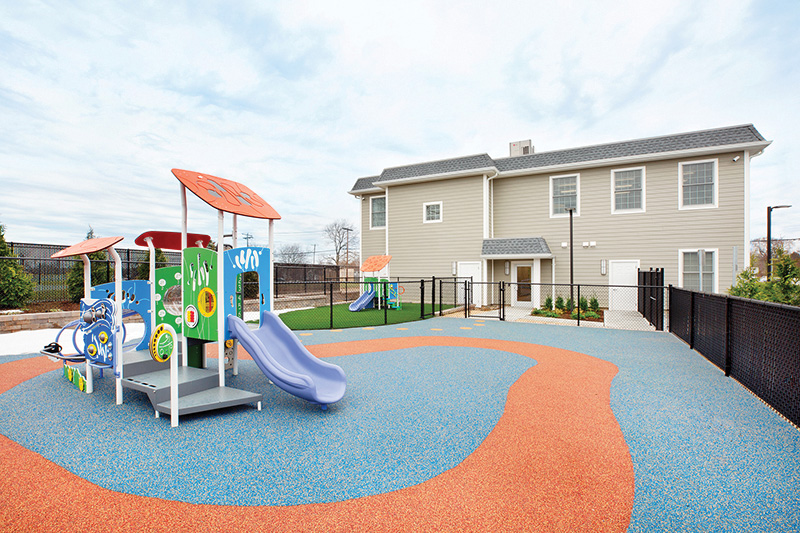
“Early childhood education centers and daycare facilities are important services for working parents at any time, and even more so during a crisis. Congratulations to Harmony Early Childhood Center on opening its new location in Wantagh, providing 115 local children and parents with a quality new option. This state-of-the-art facility where children will learn and develop important social skills will be an important asset to the community’s families,” said Nassau County executive Laura Curran.
“We are very proud of completing this beautiful new school that will serve Long Island’s families for many years to come. Built at a contracted construction cost of $3.9 million, the new building is an attractive addition to both the commercial corridor of Wantagh Ave. and the neighboring residential area,” said Troy Caruso, CEO of McAlpine Contracting.
“It is a testimony to the skill and technical acumen of our construction team that this project was completed five months ahead of schedule, despite restrictions placed on construction work during the pandemic. McAlpine’s crews have delivered this building to the owner while maintaining strict safety and infection prevention measures,” said John Nolan, McAlpine’s vice president.
“Congratulations to Harmony Early Childhood Center on their grand opening! Their focus on many important aspects of child development including technology, language, art, music, science, social skills, physical activity, and healthy habits will help to build upon our area’s record of excellent education at every level. I look forward to the great things they will do to support children in Wantagh and the surrounding communities I have the privilege to represent,” said Nassau County legislator John Ferretti.
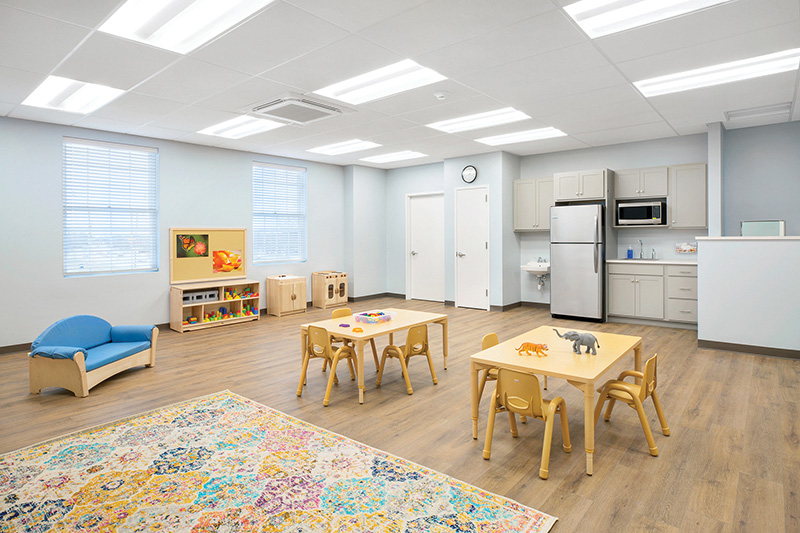
The design process called for both an architectural and regulatory expertise. “Childcare center design requires careful attention to state and municipal regulations and code requirements,” said Michael McNerney, RA, MFMA principal, who also designed Harmony’s original Levittown building. “Our collaboration for this new location began prior to the acquisition of the site to make sure that the size and functional needs of the new school could be fulfilled within the zoning requirements.”
Wantagh is located in the Town of Hempstead, and approval from the Town Board of Zoning and Appeals and from the Town Board were required before permits could be issued. The design also had to comply with Nassau County Department of Public Works and Nassau County Fire Marshal regulations, as well as New York State site and safety requirements.
Situated on a 0.58-acre plot, the two-story building with a cellar has been designed to reflect the single-family character of the surrounding residential community. According to McAlpine’s director of construction and project manager Mark Montalvo, “The façade is clad in neutral-colored HardiePlank fiber cement lap siding by James Hardie and has accents of Ply Gem cultured ledge stone on the façade section facing the street and on the column at the main entrance.” Windows are residential-type Anderson 400 Series high efficiency units with white vinyl trim.
The roof combines flat, mansard, barrel, and ridge sections to break up the building mass and create a welcoming profile. Mansards and a continuous ridge that crosses along the north-south axis are covered with Timberline HD shingles by GAF while the flat sections are protected with TPO (thermoplastic polyolefin) membrane by Versico. Standing-seam metal roofing in a galvanized aluminum finish is used at a canopy at the staff entry and clads a barrel roof extending from the west façade to the central ridge.
The floor plan is rectangular. The narrower west elevation faces Wantagh Ave., and the building spine runs west to east. Children and parents enter through the main entrance at the northwest corner that leads into the main lobby through a security vestibule. A curved counter topped with white quartz by MSI serves as a security station and reception desk. A visitor seating area with built-in benches and a decorative pendant light fixture is adjacent to the counter. The curve of the countertop draws visitors from the entry into the perpendicular double-loaded corridor that spans the length of the building. Staircases on each end of the corridor provide access to the upper and lower floors, as does an elevator, by Schindler, which is located adjacent to the lobby. Staff enters the building through an entrance that leads directly to the parking lot.
KOW joined the project team as owner’s representative early on, leading the school’s ownership through the design and construction process and advising lenders as cost management consultant. “The school is a very well designed commercial building within a residential façade and exterior. In contrast, many of Long Island’s daycares are typically one-story residential buildings, often lacking safety infrastructure typical for commercial properties, such as extensive security and sprinkler systems installed at the new Harmony school,” said Lysa Russo, LEED GA, senior staff engineer at KOW Building Consultants.
“Allison Ulin, the school’s owner, is an experienced educator and pre-school operator who has guided the functional design of the school’s facilities. For example, she requested incorporation of a 100 s/f stroller and car seat storage room, located next to the staff entrance and connected to the employee break room. Likewise, she recommended that the parent and children entranceway and vestibule are built larger than in typical preschools to make entrance and exit for parents pushing strollers, carrying car seats and other luggage, and often accompanied by more than one child easier to navigate,” said Russo.
Additional functional ideas proposed by Ulin included benches and storage furnishing. “The low bench in the corner opposite the reception desk provides a comfortable location for parents to assist their children with the removal of shoes. Similarly, another bench was built in the first floor corridor, adjacent to a large, custom cubby wall unit where parents store car seats. The interior design of the entire school is focused on the ease of use and comfort of parents and children,” said Florez.
Ulin also proposed solutions that allow parents to observe the school’s operations and their children’s activities throughout the day. These include an app that sends videos and photos of children to parents’ cell phones throughout the school day as well is installation of expansive glazed vision panels between hallways and classrooms. The classrooms also feature split Dutch doors, preventing children from leaving their rooms, while allowing parents to easily take a glimpse of activities taking place within.
“The classrooms feature open plans that accommodate the needs of teachers and students by providing sufficient space for infant feeding stations and sleeping cribs and cots for all children,” explained Ulin. “The rooms are equipped with radiant heat flooring, high quality wooden furniture, and latest digital learning aids, and allow adequate space for physical activity. For example, dance and movement areas are located in front of TV screens that will display dance classes and other educational videos and interactive games.”
The first floor houses two infant classrooms of 416 s/f each, two toddler rooms of 504 s/f each, an administrative office suite, an employee break room/locker room, and two staff and visitor bathrooms. The second floor contains four classrooms ranging in size from 560 s/f to 700 s/f each, a special purpose/meeting room, and one staff bathroom. Each classroom has a small kitchenette with a sink, refrigerator, storage casework, and a bathroom for the children. The cellar contains a residential style kitchen, with a commercial refrigerator and freezer by Everest Refrigeration, a gas oven and stove, two sinks, and cabinetry by Wolf Home Products.
According to Florez, the ownership guided the team to create the design that felt very welcoming and home-like rather than institutional. “Parents enjoy the residential feel of the school’s original location. This is reflected in the new building’s color palette and choice of finishes, such soft, desaturated blues, greens, and greys, which provide a sense of color without overwhelming. The wood plank-look flooring serves the same design purpose,” she explained. The materials were also selected for their durability and ease of cleaning and maintenance.
Walls are painted gypsum board. In the lobby, a blue-grey accent wall highlights the reception desk. Darker blue-grey millwork cabinetry in the classrooms, also by Wolf Home Products, adds a pop of color. Luxury vinyl plank flooring (LVP) in a medium wood color and grain pattern, with a whitwash finish, manufactured by MSI, extends throughout the building. The white quartz counter top of the reception desk is mirrored in the quartz tops at the classroom kitchenettes. Bathrooms are finished in porcelain tile by Daltile. Ceilings are Armstrong 2-foot x 2-foot suspended acoustic tile with 2-foot x 4-foot recessed LED lights.
In the lobby, two pendant globe fixtures brighten the reception desk, and a multi-light suspended pendant fixture above the bench seating adds interest to the space. Classroom furniture consists of flexible tables, workstations, storage walls and cabinets, and panels from the Community Playthings Roomscape collection. All pieces are in a light wood-grain color and feature smooth finish for durability and cleaning ease. Classroom chairs are by Kaplan Early Learning Company.
“Poured concrete foundation walls and two lines of structural steel columns in the cellar support metal C-stud bearing walls at the building exterior and the interior corridor of both the first and second floors. Floors on both levels are concrete slab on metal decking,” explained Mark Montalvo.
Increasing comfort of students, radiant heating is incorporated into the floor slabs in the classrooms. Two Lochinvar boilers provide hot water for the radiant system. Water flow is controlled with a CPU-0550 central processing unit by HPX Control Systems Inc. and a Taco SR502 2-zone switching relay. The boilers, hot water storage tanks, pumps, and control panels are located in the cellar.
The building has been designed with the future in mind. The double loaded corridor layout can be easily converted to commercial use if the building changes ownership in the future.
Site Design and Regulatory Requirements
“Several regulatory requirements dictated the site design. Wantagh Avenue is a Nassau County Road, and development of the site required review by the Nassau County Department of Public Works to ensure compliance with regulations for performing work within the County right-of-way per section 239-f of the New York State Municipal Code,” said McNerney. The review, performed by Nassau County, set standards for curb cuts and work adjacent to the roadway and dictated the installation an extensive drainage system, including six drywells, to contain runoff from the parking lot within the site.
In addition, the Town of Hempstead required two vehicular access points from the roadway into the site. One curb cut leads into a student drop off loop, with queue space for five cars, that directs vehicles from Wantagh Avenue past the children’s entrance to either the parking lot on the right or the exit from the site leading back to Wantagh Ave. to the left. A second curb cut serves as both an entrance and exit and leads directly into the parking lot that is located along the north face of the building. The asphalt lot contains 25 regular spaces and two handicap accessible spaces. Finally, “Town of Hempstead zoning regulations limited building area and defined minimum parking requirements, and the site had to be carefully laid out to maximize the building size while accommodating the required number of parking spaces,” said McNerney.
“A 1,600 s/f playground, designed and built by Horizon Concepts, is located adjacent to the east building entrance. The playground has two separate areas for infants and toddlers, with distinct play structures by GameTime and a combination of turf and rubber surfaces. The playground is colorful and inviting for the children,” said McAlpine Superintendent Edward Montalvo, “Horizon worked very efficiently and diligently to help us accelerate the project schedule.” Decorative metal fencing encloses the playground, while an eight-foot-high chain link fence surrounds the lot perimeter.
The site has been planted with a variety of deciduous trees, including birch, maple, and oaks, and with evergreen junipers and hollies. Flowering dogwoods, hydrangeas, azaleas, viburnum, and a variety of perennials will provide colorful visual interest. “Site work also included the connection of new electrical, water, and sanitary lines to the street mains, the relocation of telephone poles, and installation of pole lighting,” added Edward Montalvo.
Suffolk County IDA supports expansion of A&Z Pharmaceuticals


The evolving relationship of environmental consultants and the lending community - by Chuck Merritt
When Environmental Site Assessments (ESA) were first part of commercial real estate risk management, it was the lenders driving this requirement. When a borrower wanted a loan on a property, banks would utilize a list of “Approved Consultants” to order the report on both refinances and purchases.





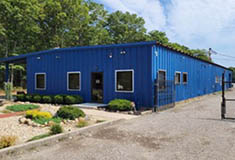



.jpg)